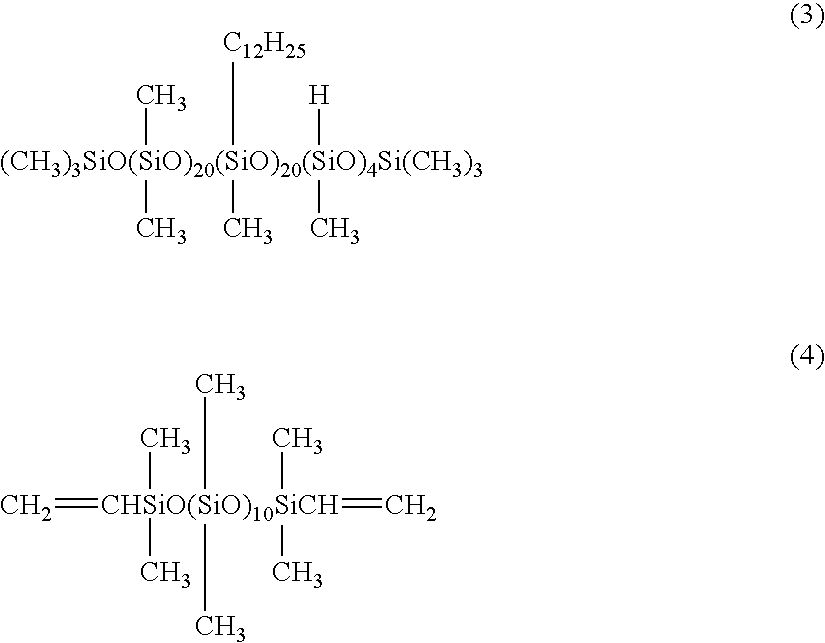Silicone microparticles comprising silicone elastomer spherical microparticles coated with polyorganosilsesquioxane, and method of producing same
a technology of silicone elastomer and spherical microparticles, which is applied in the direction of organic active ingredients, synthetic polymeric active ingredients, coatings, etc., can solve the problems of insufficient effect of powder on preventing discoloration or shininess of cosmetic materials, increase in the shine of cosmetic materials, and insufficient sebum absorption by powders, etc., to suppress changes in cosmetic make-up properties, suppress various problems, and improve the effect of cosmetic
- Summary
- Abstract
- Description
- Claims
- Application Information
AI Technical Summary
Benefits of technology
Problems solved by technology
Method used
Image
Examples
example 1
[0084]A glass beaker with a capacity of 1 liter was charged with 400 g of an organohydrogenpolysiloxane A1 represented by formula (3) shown below and having an amount of long-chain monovalent hydrocarbon groups of 22.2 mol % and a viscosity of 110 mm2 / s, and 114 g of a methylvinylpolysiloxane B1 represented by a formula (4) shown below, containing no long-chain monovalent hydrocarbon groups and having a viscosity of 10 mm2 / s (equivalent to 0.96 olefinic unsaturated groups within the methylvinylpolysiloxane B1 per SiH group within the organohydrogenpolysiloxane A1), and stirring and mixing were performed at 2,000 rpm using a homomixer. To the resulting mixed liquid were added 1.0 g of a polyoxyethylene lauryl ether (number of mols of added ethylene oxide=9 mol) and 100 g of water, and subsequent stirring at 6,000 rpm using the homomixer yielded an O / W type emulsion of increased viscosity. Stirring was continued for a further 15 minutes. Subsequently, with the stirring continued at 2,...
example 2
[0090]A water dispersion of silicone elastomer microparticles was obtained in the same manner as example 1, with the exceptions of replacing the 400 g of the organohydrogenpolysiloxane A1 with 400 g of an organohydrogenpolysiloxane A2 represented by formula (5) shown below and having an amount of long-chain monovalent hydrocarbon groups of 10.5 mol % and a viscosity of 130 mm2 / s, altering the amount of the methylvinylpolysiloxane B1 from 114 g to 113 g (equivalent to 0.91 olefinic unsaturated groups within the methylvinylpolysiloxane B1 per SiH group within the organohydrogenpolysiloxane A2), and altering the amount of water added immediately prior to obtaining the uniform white emulsion from 382 g to 383 g. Inspection of the shape of these silicone elastomer microparticles in the same manner as example 1 revealed spherical particles, and measurement of the volume average particle diameter in the same manner as example 1 yielded a result of 12 μm.
[0091]Using 876 g of the obtained wa...
PUM
| Property | Measurement | Unit |
|---|---|---|
| volume average particle diameter | aaaaa | aaaaa |
| mol % | aaaaa | aaaaa |
| mol % | aaaaa | aaaaa |
Abstract
Description
Claims
Application Information
 Login to View More
Login to View More - R&D
- Intellectual Property
- Life Sciences
- Materials
- Tech Scout
- Unparalleled Data Quality
- Higher Quality Content
- 60% Fewer Hallucinations
Browse by: Latest US Patents, China's latest patents, Technical Efficacy Thesaurus, Application Domain, Technology Topic, Popular Technical Reports.
© 2025 PatSnap. All rights reserved.Legal|Privacy policy|Modern Slavery Act Transparency Statement|Sitemap|About US| Contact US: help@patsnap.com



